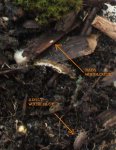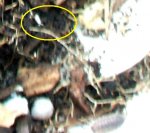In all my searching online I have never seen any photos of woodlice so young that they do not even have their proper exoskeletons. My woodlice colony had babies recently and here they are. At first I thought they might be little maggots or something, but they have the characteristic woodlousey antennae (although it's hard to see in the photos I took since my camera is not that good) and they even perform behaviours like moving their posterior up and down to drink (or expel water) through their uropods the same way the adults do (please click the images for larger versions).




